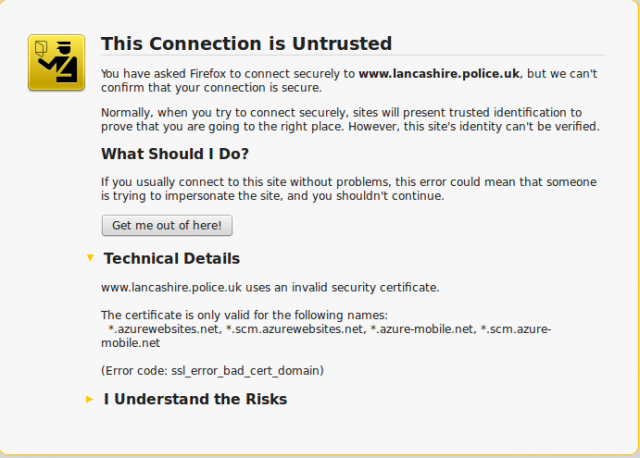This is simply depressing. Today I received a classic phishing attack email – the sort I normally bin without thought. According to virustotal, the attachment, which purported to be an MS Word document called “Invoice 7500005791.doc”, was a copy of W97M/Downloader, a word macro trojan which Symantec says is a downloader for additional malware. So far so annoying, but not unusual.
However, the email came from an address given as “@lancashire.pnn.police.uk” (so it looked as if it came from a Police National Network address allocated to Lancashire Police). Intriguingly, the “From:”, “Return-Path:” and “Return-Receipt-To:” headers all contained the same (legitimate looking) address at that domain. Only one header, “Disposition-Notification-To:” was slightly different. It gave the email address as “@lancashire.pnn.police.au”. Now that header is used to request a “Read Receipt” and most email clients will obey that and display a message of the form “This message asks for a return receipt” along with a “send” button. Had I pressed that button, a message /might/ have gone to the “police.au” domain address. I say “might” because there is no such domain, so this could simply be a mistake on the part of the attacker. All the “Received:” headers (i.e. the addresses of mail servers the message went through en route to me) were shown as network 77.75.88.xx – whois records this as belonging to an entity called “Farahnet” registered in Beirut. Unfortunately the whois record does not give an abuse, or admin contact email address.
Most phishing emails simply have a forged “From:” address and all other headers are obviously wrong. This one looked distinctly odd and a little more professional than most. I therefore decided it might be a good idea to tip off the Lancashire Police to the misuse and misrepresentation of their domain name. This is where it got depressing.
Nowhere could I find a simple email address or other electronic contact mechanism to enable me to say to Lancashire Police “Hi guys, see attached, you may have a problem”. The Lancs Police website has a “Contact Us” page giving pointers to various means of providing feedback – but no immediately obvious one for reporting email attacks. Here the banks are way ahead of the Police. All banks I have ever dealt with have an email address (usually of the form “phishing@bank.co.uk”) to which you can send details of the latest scam. However, the bottom of the contact page on the Lancs Police site shows a link to “online fraud” under the heading “popular pages”. This link takes you to their on-line safety advice page which then has a further link to “Action Fraud“, the National Fraud & Cyber Crime Reporting Centre, that site in turn does actually give you a means of reporting phishing attacks. But it takes too long. I had to click through four pages of feedback with Radio buttons asking what I wanted to report, how the attack arrived, where it purported to come from etc. before I was given a page with the email address NFIBPhishing@city-of-london.pnn.police.uk and an instruction to email them giving the details I should have been able to provide on the damned form I had just spent ages finding and filling in.
Having obtained this email adddress, I was given a “Fraud Report Summary” (see below) which is precisely useless for anything other than simple statistics. My guess is that this information is collated simply to be used to provide the sort of banal analysis beloved of senior management everywhere.
Not good enough guys, not nearly good enough.
But it gets worse. In my attempts to find what should be an obvious contact point, I plugged “lancashire police cyber crime” (I know, I know) as search terms into my search engine. The first likely entry listed in response (after rubbish like facebook pages or comments on non-existent fora such as cybercrimeops.com) was https://www.lancashire.police.uk/help-advice/online-safety/online-crime-fraud.aspx
(note the https). This is a supposedly secure link to the very same page I later found on the Lancs Police site. Try clicking that link. If you use Firefox, this is what you will get (chrome will give you something similar):
So – the site is not trusted because it uses an X509 certificate which is only valid for the commercial domains of the service on which the Police site is presumably hosted. Idiotic. If I got that sort of response from a bank I’d be deeply worried. As it is, I’m just depressed.



1 comments
Ace Site